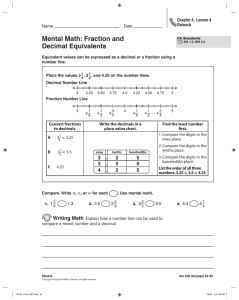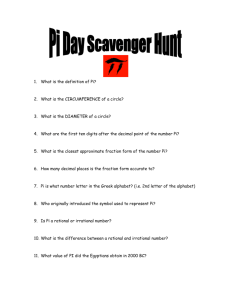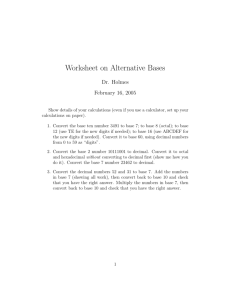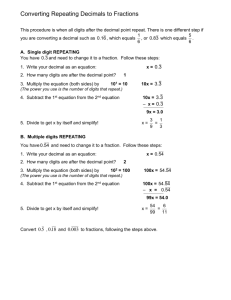Year 5 Addition and Subtraction
advertisement
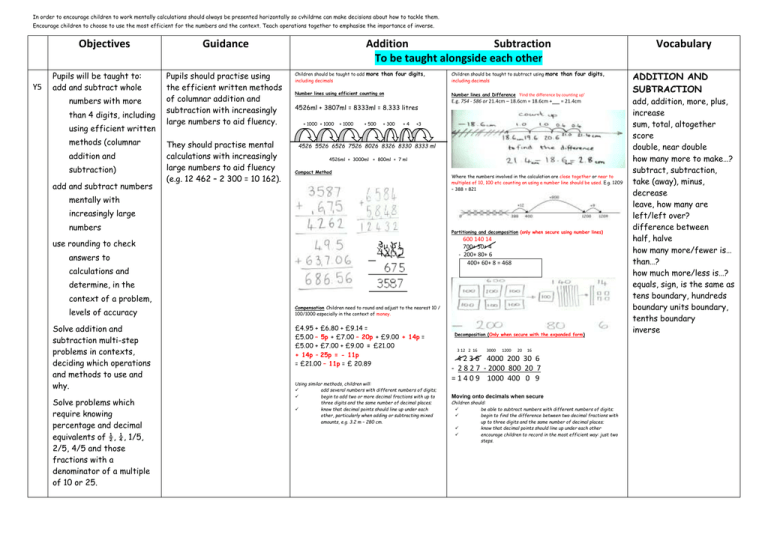
In order to encourage children to work mentally calculations should always be presented horizontally so cvhildrne can make decisions about how to tackle them. Encourage children to choose to use the most efficient for the numbers and the context. Teach operations together to emphasise the importance of inverse. Objectives Y5 Pupils will be taught to: add and subtract whole numbers with more than 4 digits, including using efficient written methods (columnar addition and subtraction) add and subtract numbers Guidance Pupils should practise using the efficient written methods of columnar addition and subtraction with increasingly large numbers to aid fluency. They should practise mental calculations with increasingly large numbers to aid fluency (e.g. 12 462 – 2 300 = 10 162). Addition Subtraction To be taught alongside each other Vocabulary Children should be taught to add more than four digits, including decimals Children should be taught to subtract using more than four digits, including decimals Number lines using efficient counting on Number lines and Difference ‘Find the difference by counting up’ 4526ml + 3807ml = 8333ml = 8.333 litres + 1000 + 1000 + 1000 + 500 + 300 +4 E.g. 754 - 586 or 21.4cm – 18.6cm = 18.6cm + = 21.4cm +3 4526 5526 6526 7526 8026 8326 8330 8333 ml 4526ml + 3000ml + 800ml + 7 ml Compact Method Where the numbers involved in the calculation are close together or near to multiples of 10, 100 etc counting on using a number line should be used. E.g. 1209 – 388 = 821 mentally with increasingly large numbers Partitioning and decomposition (only when secure using number lines) 600 140 14 700+ 50+ 4 - 200+ 80+ 6 400+ 60+ 8 = 468 use rounding to check answers to calculations and determine, in the context of a problem, levels of accuracy Solve addition and subtraction multi-step problems in contexts, deciding which operations and methods to use and why. Solve problems which require knowing percentage and decimal equivalents of ½, ¼, 1/5, 2/5, 4/5 and those fractions with a denominator of a multiple of 10 or 25. Compensation Children need to round and adjust to the nearest 10 / 100/1000 especially in the context of money. £4.95 + £6.80 + £9.14 = £5.00 – 5p + £7.00 – 20p + £9.00 + 14p = £5.00 + £7.00 + £9.00 = £21.00 + 14p – 25p = - 11p = £21.00 – 11p = £ 20.89 Using similar methods, children will: add several numbers with different numbers of digits; begin to add two or more decimal fractions with up to three digits and the same number of decimal places; know that decimal points should line up under each other, particularly when adding or subtracting mixed amounts, e.g. 3.2 m – 280 cm. Decomposition (Only when secure with the expanded form) 3 12 2 16 3000 1200 20 16 4 2 3 6 4000 200 30 6 - 2 8 2 7 - 2000 800 20 7 = 1 4 0 9 1000 400 0 9 Moving onto decimals when secure Children should: be able to subtract numbers with different numbers of digits; begin to find the difference between two decimal fractions with up to three digits and the same number of decimal places; know that decimal points should line up under each other encourage children to record in the most efficient way: just two steps. ADDITION AND SUBTRACTION add, addition, more, plus, increase sum, total, altogether score double, near double how many more to make…? subtract, subtraction, take (away), minus, decrease leave, how many are left/left over? difference between half, halve how many more/fewer is… than…? how much more/less is…? equals, sign, is the same as tens boundary, hundreds boundary units boundary, tenths boundary inverse In order to encourage children to work mentally, calculations should always be presented horizontally so children can make decisions about how to tackle them. Encourage children to choose to use the most efficient method for the numbers and the context. Teach operations together to emphasise the importance of inverse. Children will also be encouraged to check their work using the inverse or a different method e.g. equivalent calculation and by estimation where appropriate. They can represent and explain how to solve problems using the operations with increasing independence.

